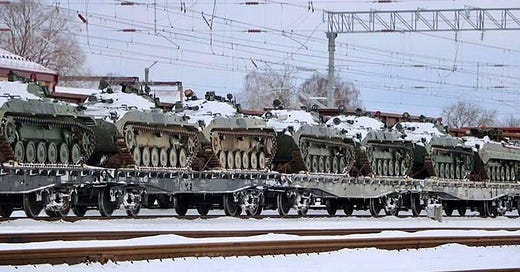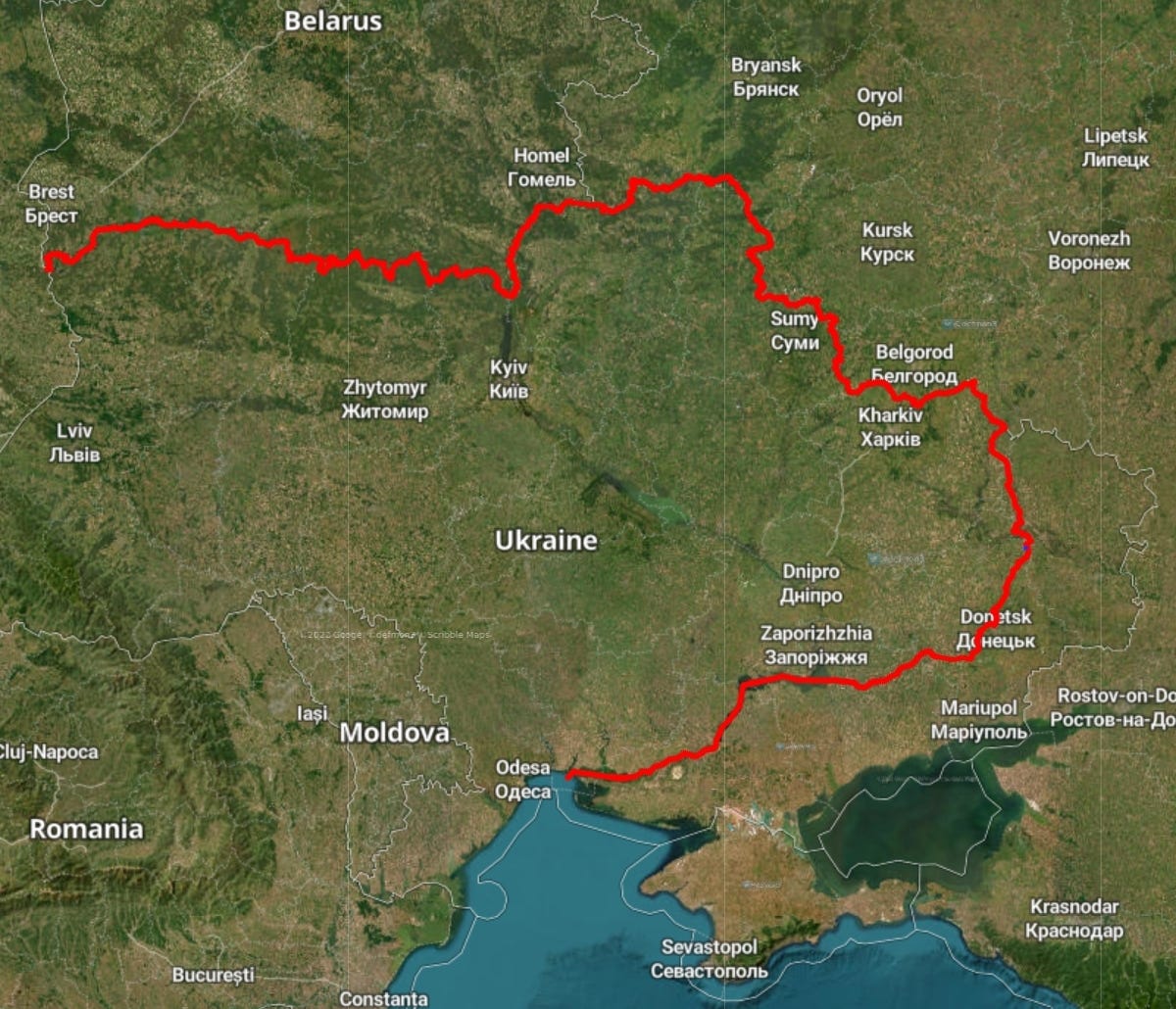I have touched upon this subject in some of my previous articles, but this time I will look at the prospect of a Russian winter offensive with a wider lense. Don't consider this as an attempt to predict the future, though I will outline and discuss several possible alternatives to illustrate some dilemmas, challenges and opportunities for Russia. Predicting what they actually end up doing is a different exercise, and at this stage remains a very open question.
The Ukrainian leadership think something is brewing, seemingly takes the prospect of new Russian offensives seriously, and has recently gotten vocal about it .1
Opinions among observers on whether new Russian offensives are realistic differ. Partly due to their poor performance, the current state of the Russian forces and their capabilities, and the quality of personnel and units raised through the mobilization. Another important factor in this equation is the Ukrainian battlefield performances, making a Russian offensive largely conducted by mobilized personell seem like a doomed enterprise. Developments in war are inherently difficult to forecast, so I would caution against underestimating Russia as the war drags on, especially when it comes to Russias mobilization potential and their desire to push forward.
With that said, the goal of this article is to help prevent a failure of imagination when it comes to assessing future Russian operations, especially among Western observers.
What follows hinges on some assumptions that the reader should keep in mind throughout this article and when reading future articles in what will likely be a series of atleast two parts.
Key assumptions
Russia’s original war-aims remains unchanged and Moscow is planning for a long war.
Russian ammunition stockpiles, especially for artillery, are sufficient to support offensive operations this winter.
Russia is able to establish minimum one grouping of forces, which at least is capable of a limited operational level offensive operation.
The strike campaign against Ukrainian critical infrastructure continues.
Winter offensive - Proposed Russian strategic objective
Prevent large scale Ukrainian offensives this winter, regain the strategic initiative, and set the stage for further offensive operations in the summer of 2023.
I obviously don't know what the Kremlin and the Russian General Staff actually thinks when it comes to the objectives of future operations. For the purpose of discussing a winter offensive, I have devised an objective above which I think both makes sense strategically and being relatively limited, also realistic.
Wars are won through a series of campaigns and battles, hence I state that the purpose of a winter offensive is to enable further offensives later on, as a “decisive battle” or “knockout blow” is highly unlikely.
Ukrainian forces and offensive(s) this winter
I assess that Ukraine still holds the initiative and would benefit from maintaining pressure through the winter, but accurately determining Ukrainian offensive potential is difficult due to tight operational security. The Ukrainians have repeatedly outperformed the Russians on the battlefield, but attrition is taking it's toll on Ukraine as well. Statements made to the Economist2 suggest that uncommitted reserves does exist and new units are also being formed and trained.
A major factor influencing future Ukrainian offensives is munitions availability. Currently demand far outstrips production, both for legacy and western supplied systems. The critical infrastructure campaign also puts a strain on air-defences and shortfalls here could enable a stronger Russian Air Force effort at a later stage.
On the frontlines, Ukraine is facing increasingly fortified defensive lines, and higher Russian force density due to the mobilization. This, coupled with the Russians also learning and adapting, makes it more likely future Ukrainian offensives will resemble the Kherson operation rather than Kharkiv.
For Russia, stopping further Ukrainian gains is likely a priority. One way of doing that, instead of being reactive and remain on the defensive, letting Ukraine keep the initiative, is switching to the offense somewhere. This would then force Ukraine to react, possibly diverting forces and reserves intended for own offensives, to a place of Russian choice. I see this as the main rationale for a Russian offensive this winter, so now I'll start looking as some Russian options, beginning with the current active frontline.
Frontlines December 20223
Offensives on the current active front
As of December, the frontlines are relatively stable despite heavy fighting around Bakhmut, Vulhedar and the northern part of the front, from Siversk to the Russian border.
The Zaporizhzhia front has remained relatively quiet and stable for months, though there are speculations of a future Ukrainian offensive in this area.
With the Russians on the east bank of the Dnipro, this part of the front is stable and will likely remain so. Both sides are unlikely to conduct major operations on the lower Dnipro without preceding developments elsewhere.
Behind the Russian lines, both on the northern part of the front and also in Zaporizhzhia, extensive work is underway constructing fortified lines. This is indicative of a defensive stance, but doesn't rule out future offensive either. Fighting has yet to reach these lines too.
Any new offensive along the existing front would likely run into extensive Ukrainian defenses, risking high casualties for questionable gains. Both sides have struggled to achieve breakthroughs against determined and dug-in resistace so far in this war. It would also allow Ukraine concentrate reserves for decisive counterattacks, potentially turning a Russian offensive into a Ukrainian counter-offensive.
A reinforced effort around Bakhmut, for instance, could serve as a means to take more of Luhansk and Donetsk Oblast.
From a good thread trying to explain Bakhmut
While Russia likely could take more ground, they'll just run into new Ukrainian defensive lines further west, and likely still be a long way from conquering Donetsk Oblast when the offensive culminates.
A limited operation in the Pavlivka/Vulhedar direction, to push Ukrainian artillery beyond range of the Melitopol - Donetsk railway and ease logistics in the south is another possibility. This could possibly also be conducted in parallel with the other alternatives I look at later.


A larger advance towards Zaporizhzhia and Dnipro from the south is another option, but due to reasons explained under the next headline, feasibility of this may be low.
In my opinion, operations on the current active frontlines wouldn't put Russia closer to achieving their strategic objectives or war-aims. Any gains will likely come at a high price in casualties, without Russia coming much closer to defeating Ukraine.
The geography and logistics
It is well known that Russian logistics are bound to the railroads. The introduction of HIMARS forced them to adapt, placing hubs farther away, relying more on trucks and dispersal.
HIMARS, in conjunction with the damage to the Kerch railway bridge, has put a strain on Russian logistics in the south. Therefore I find it unlikely that Zaporizhzhia will be the place of a winter offensive, as both deploying large additional forces and sustaining them for an offensive there likely is beyond the capabilities of the current logistics system. If Russia could get the Donetsk - Melitopol railway operational, it could reopen this option, but that likely pushes the timeframe beyond the winter.
There are however two factors that allows Russia to concentrate forces, and sustain them, at a time and place of their choosing. That is the Western refusal to supply long range systems and the caveats barring Ukraine from using current Western supplied systems to strike targets inside Russia itself. This gives the Russians a safe haven when outside barrel artillery range, stretching from Belgorod Oblast through Belarus to the Polish border. Here they can concentrate forces and supplies for new offensives relatively uninterrupted.
Northern part of the frontline and the area east of Kharkiv4
There is one area where the Russians can combine making preparations in their safe haven with operations on the current active front and that’s on the northern end. By pushing south from Belgorod Oblast, this part of the Ukrainian lines can be outflanked. The downside would be giving up an opportunity to force Ukraine to really split it's forces as distances are short, units can be moved relatively quick, and enablers such air-defences and HIMARS could support defensive operations in several directions simultaneously.
Operations from Belgorod could vary in scale, from just tying down Ukrainian forces to the border, via an attempt at taking back ground lost in September, to a new attempt to take Kharkiv. The overall picture however likely doesn't change much with any of these option, even if the Russians succeed, and an attempt to take Kharkiv could turn into a urban grinder making Bakhmut look pale in comparison.
Better opportunities, both to force Ukraine to shift significant forces longer distances, thereby preventing Ukrainian offensives while simultaneously laying the groundwork for further operations in the summer of 2023, may be found elsewhere.
In part 2, I will look into the possibilities offered by a winter offensive somewhere on northern front, that is from Belarus and/or Bryansk Oblasts.
Regards
The Lookout
https://www.economist.com/ukraines-fateful-winter
https://www.economist.com/ukraines-fateful-winter
Defmon3s interactive map: https://www.scribblemaps.com/maps/view/2022051301800/nBT8ffpeGH
Defmon3s interactive map: https://www.scribblemaps.com/maps/view/2022051301800/nBT8ffpeGH








Trying to repeat WW II history of Zhukovs winter offensives.
First to throw back the germans from Moscow and again to take advantage of stalemate in Stalingrad to encircle german forces.
Not to mention Finlands winter war when they used a winter offensive.
Think Bahkmut as a black hole for Ukrainian forces while trying to break out on either side.
Dubious but remember Russians are students of history not to learn frrom it but to repeat it.